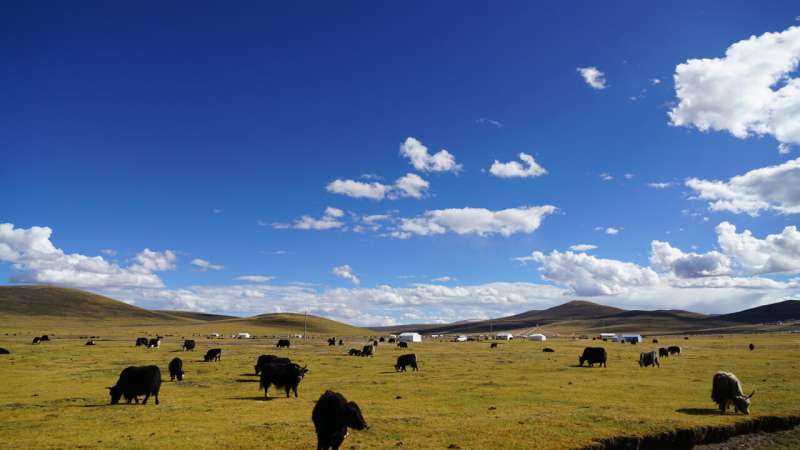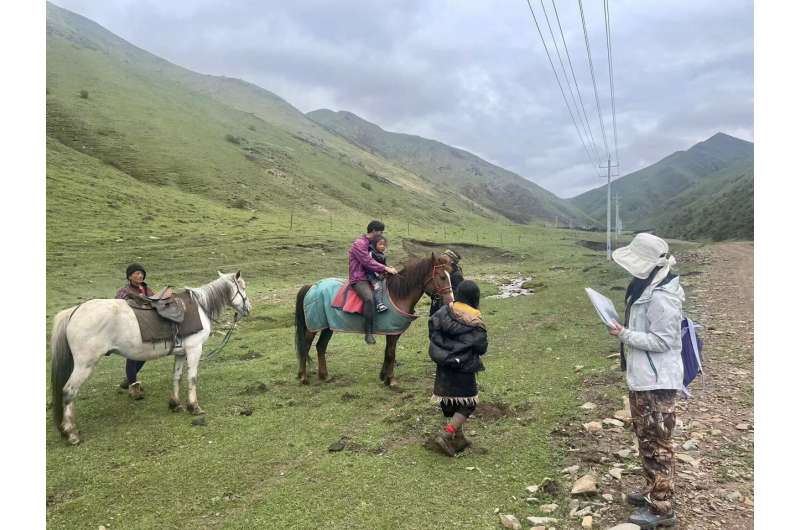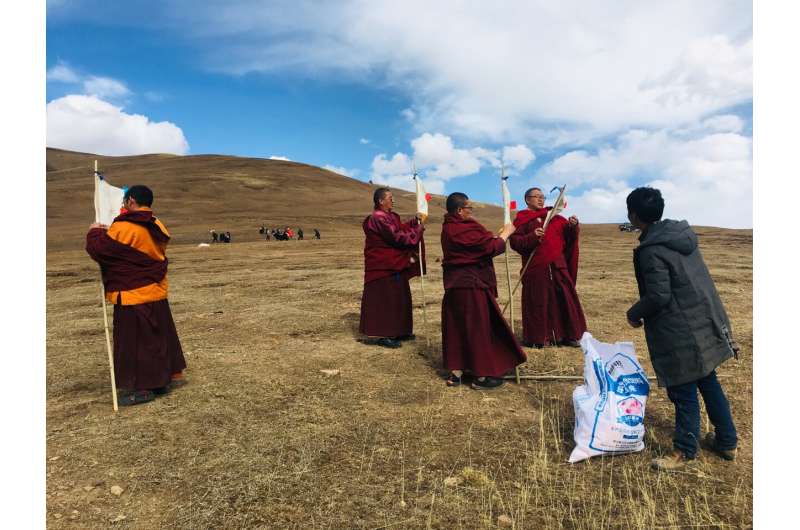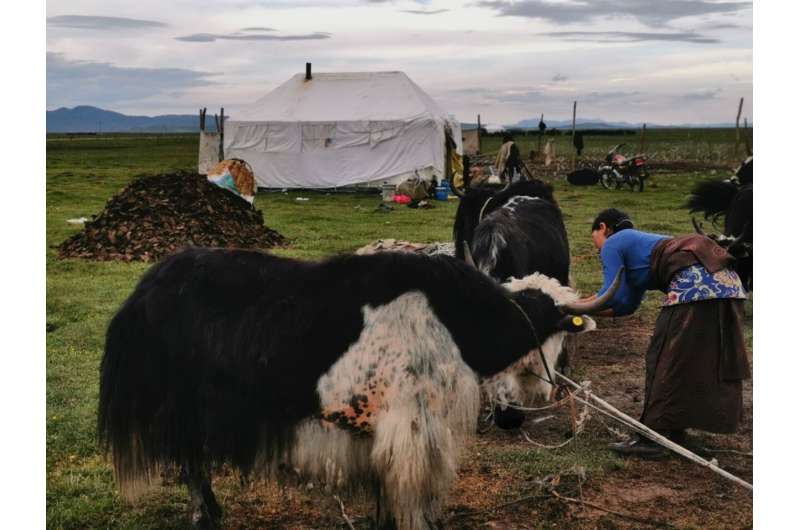Combining community values and science is key to ecosystem restoration, study shows


Yaks and tents on an autumn pasture on the Qinghai-Tibet Plateau in northwest China. Photo credit: Yuqiu Li
One of the world’s largest ecosystem restoration projects is taking place on the “Roof of the World”. The Qinghai-Tibet Plateau (QTP) in western China is the highest plateau in the world and covers an area about five times the size of France.
This vital ecosystem is home to thousands of rare plants and animals and the water source for more than 2.5 billion people – but it is under threat.
Due to climate change and intensive livestock grazing, the region’s grasslands are degrading. Government initiatives to restore biodiversity and soil fertility are underway, but the lack of engagement of local communities is one of the main reasons for the failure of these projects.
A research team of local Tibetans and academics from the UK and China have lived and studied two pastoral communities in the QTP for decades to examine local attitudes and values towards grassland restoration.
The team’s results, published in the journal human and naturedemonstrate that local community members are essential partners in strengthening community engagement in repairing damaged ecosystems and achieving long-term success.
Some active and influential members in local communities act as information and partnership ‘brokers’, communicating with other members about new techniques, such as grassland reforestation, in ways that are consistent with local cultural views and values.
Huxuan Dai, lead author and PhD student at Xi’an Jiaotong-Liverpool University (XJTLU), China, and the University of Liverpool, UK, says: “Top-down recovery strategies often rely on narratives dominated by scientific evidence that ignore or fail to address local concerns.”
“Understanding a community’s value system and fundamental views on environmental change is a first step in our efforts to facilitate community participation in ecological restoration projects.
“Policymakers and restoration funders should learn from this study and develop strategies to better engage local communities and improve the long-term sustainability of restoration and other community-involved environmental management initiatives,” says Dai.
Changing the narrative
To understand attitudes and participation in grassland restoration, researchers interviewed local ranchers and examined the success of community initiatives.

Herders on horseback are interviewed by researchers about grassland restoration on the Qinghai-Tibet Plateau in northwest China. Photo credit: Li Li
The study identified eight types of pastoralists with different attitudes toward grassland restoration within two QTP communities, Nyanze and Kouta (pseudonyms).
They found that the Nyanze community group called “Active Agents” promoted the highest level of community engagement in grassland restoration. Most of this group are secular or religious elites in the community, such as village chiefs, educated youth, and Buddhist monks, with 90.9% not considering themselves low-income earners.
“The Active Agents consciously integrated the novel grassland restoration efforts into local worldviews and values. They created new, inclusive narratives that made grassland restoration culturally acceptable and consistent with local values, thereby increasing community participation in restoration efforts,” says Dai.
Dai explains that excluding local values from discussions about new restoration techniques could lead some pastoralists to conclude: “Herders do not practice agriculture” and “When replanting, one must plough the land, which can kill worms under the ground; killing is considered bad behavior in Buddhism.”
Instead, local people can offer a different interpretation of these techniques that takes into account local perspectives and values.

A ritual to evict a pika (small mammal) at a grassland restoration site on the Qinghai-Tibet Plateau in northwest China. Photo credit: Li Li
Dai says, “Value-based narratives link reforestation to the local Buddhist value of showing compassion towards all living beings. For example, ‘reforestation’ means creating a world for all living beings, as they would not survive if the grassland was destroyed. It means providing them with a home when you restore it.”
“This values-based approach recognizes the connection of local people to their land and culture and promotes sustainable practices for managing high-altitude ecosystems,” she says.
Beyond research
In addition to the scientific significance of the project, it was a great motivation for the research team to observe and experience the effects of grassland degradation on the Qinghai-Tibet Plateau and the interactions with the local population.
Dr. Li Li, the corresponding author of the study, explains: “The research team consists of local people and researchers; Mr. Trachung Balzang and Mr. Golog Drugkyab are Tibetans born in this area who have witnessed great changes in the grassland. They have dedicated decades to protecting their homeland and their love for this land.

A cattle herder tends her cattle outside her tent at dusk on the Qinghai-Tibet Plateau in northwest China. Photo credit: Huxuan Dai
“We have all lived in this area of the QTP, made friends with the locals, and care about this place and its people. We have gained insights about life and the world and have been inspired by it. Therefore, with the connection to this land, the research team aims to promote the long-term effectiveness of grassland restoration efforts,” says Dr. Li.
The next research steps will focus on how communities can gain knowledge about grassland restoration through adaptive management and how knowledge dissemination can lead to transformative change at the regional scale.
More information:
Dai et al. (2024) Communities in ecosystem restoration: The role of inclusive values and narrative innovations of local elites, human and natureDOI: 10.1002/pan3.10675 , besjournals.onlinelibrary.wile … i/10.1002/pan3.10675
Provided by Xi’an Jiaotong-Liverpool University
Quote: Combining community values and science is key to ecosystem restoration, study shows (July 8, 2024), accessed July 8, 2024, from https://phys.org/news/2024-06-combining-community-values-science-key.html
This document is subject to copyright. Except for the purposes of private study or research, no part of it may be reproduced without written permission. The contents are for information purposes only.



